人教版七年级英语上册第六课时 Section B (3a-3b)—单元同步作文指导
人教版七年级英语上册第六课时 Section B (3a-3b)—单元同步作文指导
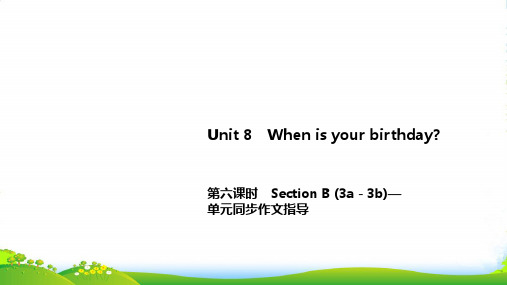
________________________________________________________________________
________________________________________________________________________
•不习惯读书进修的人,常会自满于现状,觉得再没有什么事情需要学习,于是他们不进则退。经验丰富的人读书用两只眼睛,一只眼睛看到纸面上的话,另 一眼睛看到纸的背面。2022年4月3日星期日2022/4/32022/4/32022/4/3 •书籍是屹立在时间的汪洋大海中的灯塔。2022年4月2022/4/32022/4/32022/4/34/3/2022 •正确的略读可使人用很少的时间接触大量的文献,并挑选出有意义的部分。2022/4/32022/4/3April 3, 2022 •书籍是屹立在时间的汪洋大海中的灯塔。
⑤When is Sally's birthday party?莎莉的生日聚会在什么时候? ⑥It's on October 5th.在十月五号。 ⑦Do you like...?你喜欢……吗?
⑧Please come to... next week.请下周来…… ⑨We have a/an...我们有一个…… ⑩See you there!那里见! 拓展相关句型:
谢谢观赏
You made my day!
我们,还在路上……
Unit 8 When is your birthday?
第六课时 Section B (3a-3b)— 单元同步作文指导
本单元的写作旨在锻炼大家熟练运用英文表达日期的能力,重点是1到30的序数词的表达和12个月份 的表达方式。同学们只要熟练掌握以上两点,这类作文就不在话下了。在熟练运用所学知识的基础上 ,具体到书面表达中,一是要学会如何表达自己的生日、同学的生日以及家人的生日;二是要学会写
七年级英语上册Unit6第五课时SectionB(3a_3b)单元写作清课件新版人教新目标版ppt
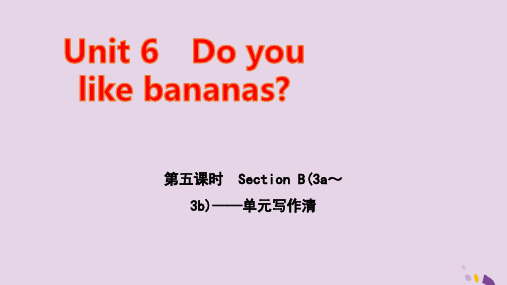
实战演练 假如你是赵玲,你的好友Sally有着健康的饮食习惯。下面的表格是她一日三餐 的食物单。请你根据表格中的内容写一篇英语短文,向大家介绍一下Sally的饮 食情况。
Breakfast Lunch Dinner
milk, eggs rice, chicken, vegetables, salad
实用参考词汇及句型: 1.打篮球 _p_l_a_y____ _b_a_s_k_e_t_b_all 2.篮球明星 ___a_____ba_s_k_e_t_b_a_l_l _____s_t_a_r 3.鸡肉和蔬菜 c_h_i_c_k_e_n__ __a_n_d____ve_g_e_t_a_b_l_e_s 4.早餐吃鸡蛋 ___e_a_t___ _e_g_g_s____ f_o_r_____b_re_a_k_f_a_s_t__ 5.我喜欢牛奶。 _I__l_i_k_e__m_i_l_k_.___________________________________________
表达储备
1.John likes hamburgers. 2.I don't like salad. 3.I think John likes strawberries and apples. 4.I like fruit, but I don't like vegetables. 5.I love fruit. I think it's healthy. 6.I don't like bananas.
人教版英语七年级上册 Unit 6 Section B教案
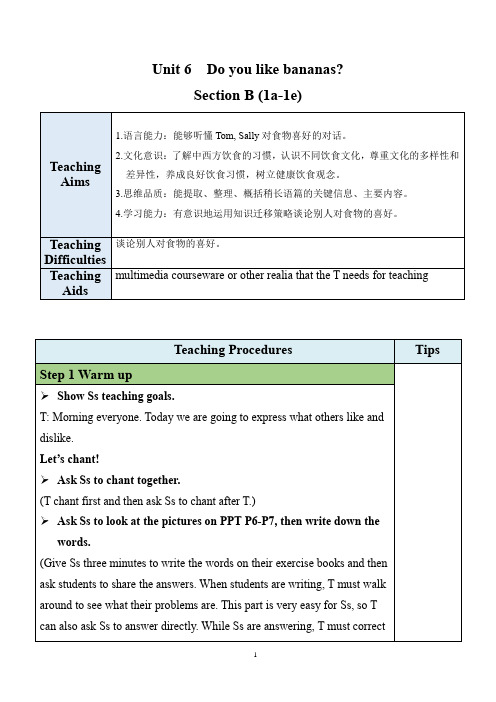
Unit 6 Do you like bananas?Section B (1a-1e)Unit 6 Do you like bananas?Section B (2a-2c)➢Ask Ss to write more healthy food and unhealthy food.Answers will vary.While-readingFirst Reading➢Reading Tip 1: PredictingT asks Ss to look at the title and pictures in 2b, try to predict: What's the article about?(T tells Ss what predict is: to have a guess. Any answer is OK here. Ss can tell the reason why they guess so.)Second Reading➢Reading Tip 2: scanningAsk Ss to scan the passage and complete the thinking map.➢Reading Tip 3: ScanningAsk Ss to judge which sentence is right and which sentence is wrong according to the passage.Answers: 1. F 2. F 3. T 4. T 5. TThird Reading➢Reading Tip 4: RetellingT asks Ss to retell the passage.(T can use the table above and give some clues to help Ss retell. T can say the first words of the sentences or use transitional words or questions to remind them of the next sentence if students forget. There will be somegrammatical mistakes when they are retelling, so teachers must use some transitional words to connect the sentences together, or to correct their pronunciations.)2b➢Ask Ss to read the magazine article and circle the food words.➢T ask Ss to write down the food that Cindy likes for meals and David likes for meals.T: Just now you have circled all the words about food. What does Cindy like for breakfast, lunch and dinner? What does David like for breakfast, lunch and dinner? Now write B for breakfast, L for lunch and D for dinner after the words.➢Let each S take out a piece of paper. Show Ss PPT P18 and ask them to write down the Chinese translation for each phrase.2c➢Ask Ss to write down five sentences about Cindy’s eating habits. While Ss are completing 2c, walk around the room and look at the sentence of different Ss. Choose sentences in which there are common errors, and write these sentences on the board. Then have Ss work in pairs to find the errors and suggest corrections. Elicit from Ss how to correct the sentences, and make the corrections on the board.Answers will vary.Post-reading➢Optional choice: Divide Ss into groups of four. Ask them to discuss what they like to eat for each meal. T can encourage Ss to say more about their preferences, e.g. I like ... but I don’t like ..., I always / never have ... for ... (T can write these sentences on the board if necessary).Unit 6 Do you like bananas? Section B (3a-Self Check)Exercise 1➢Ask Ss to write the plural forms of the words in the box on the left, then put them into the correct columns.Answers 1:Exercise 2➢First, ask Ss to choose a topic (i.e. the food / sports / colors they like or dislike), then let them write five sentences for that topic. Answers will vary.Exercise 3➢Tell Ss that they need to think about the food / sports / colors their parents like and write five sentences.Answers will vary.(T can encourage Ss to correct each other’s sentences first, then pick some Ss to read their answers to the whole class. )。
2018秋人教版七年级英语上册Unit 6 Do you like bananas ?课件:Unit 6 SectionB (3a-Self Check)
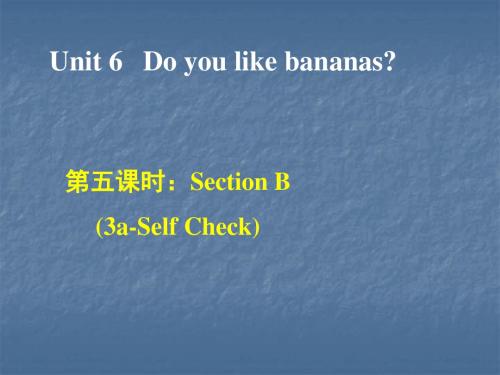
y→i+es
strawberry, dictionary, family
Self Check 2
What food, sports and colors do you like and dislike?
I like milk,eggs,basketball,ping-pong,orange and red. I don't like hamburgers,salad,ice-cream,baseball, soccer,blue and black.
morning, he runs(跑步) _______2 his sister.liHkeslikes Liu Xiang, a
great running ______3 from China. He also likes playing pingwith
-pong. He can play it very ______4. Every afternoon he plays it
table dictionary egg
apple pear
radio
vegetable family
pencil
key
volleyball
+s
+es
hamburger,carrot, photo,banana,hat, table,egg,apple, tomato pear,radio, vegetable,pencil, key,volleyball
3b
Write about what you and your partner like and don‘t like for breakfast,lunch and
dinner.
For breakfast,I like __b_r_e_a_d_,but I don't like_h_a_m__b_u_r_g_e_r_s __o_r__eg_g_s_______. For lunch,_________________________________________. And for dinnIerl,ike__r_ic_e_a_n_d__v_e_g_e_t_a_b_le_s_,__b_u_t_I__d_o_n_'t_l_i_k_e_s_a_la_d_.
人教版英语七年级上册 Unit 1 Section B (3a—3b)
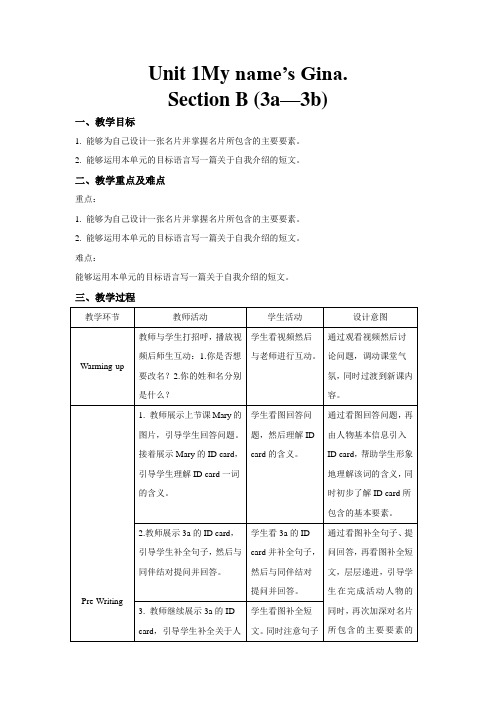
Unit 1My name’s Gina.
Section B (3a—3b)
一、教学目标
1. 能够为自己设计一张名片并掌握名片所包含的主要要素。
2. 能够运用本单元的目标语言写一篇关于自我介绍的短文。
二、教学重点及难点
重点:
1. 能够为自己设计一张名片并掌握名片所包含的主要要素。
2. 能够运用本单元的目标语言写一篇关于自我介绍的短文。
难点:
能够运用本单元的目标语言写一篇关于自我介绍的短文。
三、教学过程
四、板书设计
Unit 1My name’s Gina.
Section B (3a—3b) Introducing the ID card
➢Name:What’s your name?
➢First name: What’s your first name?
➢Last name: What’s your last name?
➢Telephone number: What’s your telephone number?
➢School: What’s your school’s name?
➢…。
七年级-人教版-英语-上册-Unit-6-Section-B-(3a-Self-Check)

Colors
white, black, red, orange, yellow, green, blue, pink, purple, brown ...
I like ... and I like ... / I like ..., but I don’t like ...
Self Check
3 What food, sports and colors do your parents like and dislike? Write at least five sentences.
hamburgers photos tomatoes strawberries
hats
eggs
dictionaries
radios
pencils
families
bananas tables
apples
vegetables
radio pencil
vegetable family
key
volleyball
Self Check
3 What food, sports and colors do your parents like and dislike? Write at least five sentences.
____________________________________________. ____________________________________________. ____________________________________________. ____________________________________________. ____________________________________________.
2024年人教版七年级英语上册教学Unit 6 第三课时 Section B (1a-2b)
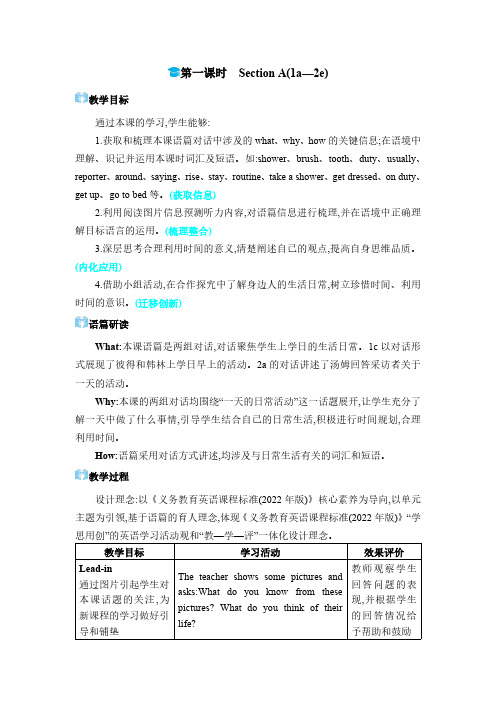
第一课时SectionA(1a—2e)教学目标通过本课的学习,学生能够:1.获取和梳理本课语篇对话中涉及的what、why、how的关键信息;在语境中理解、识记并运用本课时词汇及短语。
如:shower、brush、tooth、duty、usually、reporter、around、saying、rise、stay、routine、take a shower、get dressed、on duty、get up、go to bed等。
(获取信息)2.利用阅读图片信息预测听力内容,对语篇信息进行梳理,并在语境中正确理解目标语言的运用。
(梳理整合)3.深层思考合理利用时间的意义,清楚阐述自己的观点,提高自身思维品质。
(内化应用)4.借助小组活动,在合作探究中了解身边人的生活日常,树立珍惜时间、利用时间的意识。
(迁移创新)语篇研读What:本课语篇是两组对话,对话聚焦学生上学日的生活日常。
1c以对话形式展现了彼得和韩林上学日早上的活动。
2a的对话讲述了汤姆回答采访者关于一天的活动。
Why:本课的两组对话均围绕“一天的日常活动”这一话题展开,让学生充分了解一天中做了什么事情,引导学生结合自己的日常生活,积极进行时间规划,合理利用时间。
How:语篇采用对话方式讲述,均涉及与日常生活有关的词汇和短语。
教学过程设计理念:以《义务教育英语课程标准(2022年版)》核心素养为导向,以单元主题为引领,基于语篇的育人理念,体现《义务教育英语课程标准(2022年版)》“学思用创”的英语学习活动观和“教—学—评”一体化设计理念。
教学目标学习活动效果评价Lead-in通过图片引起学生对本课话题的关注,为新课程的学习做好引导和铺垫The teacher shows some pictures andasks:What do you know from thesepictures?What do you think of theirlife?教师观察学生回答问题的表现,并根据学生的回答情况给予帮助和鼓励设计意图以图片和问题导入,给学生更直观的感受,以此引入本节课的话题,引起学生的思考,激发学生的思维【学习理解】Activity1:Match通过匹配时间和图片,引出新的时间表达方式,为下一步听力活动做好准备1.Here are some pictures.Match theclocks with the times.2.Learn the ways to express times.教师观察学生完成匹配任务的情况,根据学生的表现预判学生的能力并了解学生的已知内容设计意图通过图片匹配,学生学会用英文来表达时间【学习理解】Activity2:Listening practice1通过完成不同层次的听力活动,输入新的词汇及句型,培养学生获取关键信息的能力及语感1.Work on1b、1c and1d.Then checkthe answers.2.Listen carefully and pay attention tothe time.教师观察学生是否能够按要求完成听力任务。
人教版英语七年级上册Unit6SectionB3a3b优秀教学案例
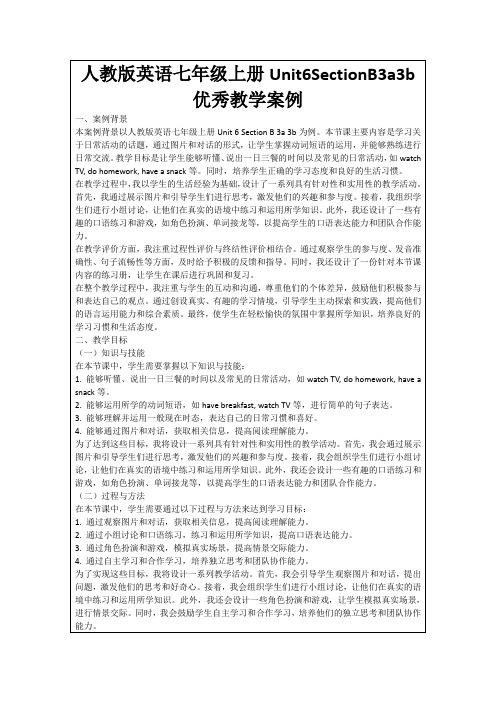
(二)问题导向
问题导向是引导学生主动探索和思考的教学策略。在本节课中,我设计了一些问题,激发学生的思考和好奇心。问题导向包括以下几个方面:
1.分组讨论:将学生分成小组,让他们在小组内进行讨论和交流,共同完成任务。例如,让学生分组讨论并表演一段关于日常活动的对话,培养他们的口语表达能力和团队合作能力。
2.小组竞赛:设计一些小组竞赛活动,激发学生的团队合作精神和竞争意识。例如,进行单词接龙游戏,看哪个小组能够连续接出更多的单词。
3.小组分享:鼓励学生在小组内分享自己的观点和经验,培养良好的沟通和倾听能力。例如,让学生在小组内分享自己的一日三餐时间和日常活动安排,互相学习和借鉴。
人教版英语七年级上册Unit6SectionB3a3b优秀教学案例
一、案例背景
本案例背景以人教版英语七年级上册Unit 6 Section B 3a 3b为例。本节课主要内容是学习关于日常活动的话题,通过图片和对话的形式,让学生掌握动词短语的运用,并能够熟练进行日常交流。教学目标是让学生能够听懂、说出一日三餐的时间以及常见的日常活动,如watch TV, do homework, have a snack等。同时,培养学生正确的学习态度和良好的生活习惯。
为了实现这些目标,我将营造一个轻松愉快的学习氛围,鼓励学生积极参与和表达自己的观点。通过小组讨论和团队合作活动,培养学生的团队合作精神和良好的人际交往能力。同时,我会给予学生积极的反馈和指导,让他们感受到学习的成就感和乐趣。通过与学生的互动和沟通,引导他们树立正确的学习态度和价值观,努力提高自己的综合素质。
人教版英语七年级上册Unit6SectionB3a3b教学设计
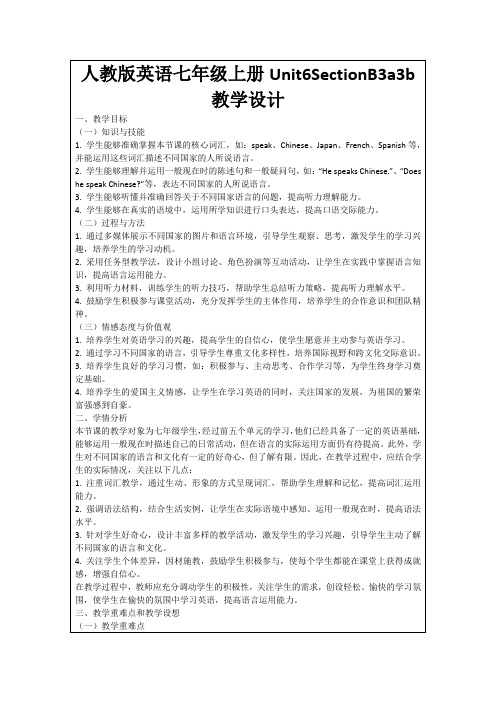
3.教师提出问题:“Do you know what language people speak in different countries?”,引导学生思考并回答,为新课的学习内容做好预热。
(五)总结归纳
1.教师引导学生回顾本节课所学词汇、语法、听力等知识点,总结学习收获。
2.教师强调本节课的重点,提醒学生注意一般现在时的用法和不同国家语言的掌握。
3.教师布置课后作业,如:用英语介绍一个国家的语言和文化,要求学生充分发挥所学知识,提高学生的自主学习能力。
4.教师鼓励学生继续关注不同国家的语言和文化,培养国际视野,为下一节课的学习做好铺垫。
-通过小组合作,让学生互相交流所学词汇,提高词汇运用能力。
2.针对语法教学:
-创设情境,让学生在实际语境中感知语法结构,如通过角色扮演,模拟不同国家的人交流的场景。
-设计语法填空、改错等练习,让学生在实践中掌握语法知识。
-利用图表、思维导图等可视化工具,帮助学生梳理语法知识点,形成系统化认识。
3.针对听力教学:
4.教师及时批改作业,给予学生反馈,指导学生改进学习方法,提高学习效果。
3.培养学生良好的学习习惯,如:积极参与、主动思考、合作学习等,为学生终身学习奠定基础。
4.培养学生的爱国主义情感,让学生在学习英语的同时,关注国家的发展,为祖国的繁荣富强感到自豪。
二、学情分析
本节课的教学对象为七年级学生,经过前五个单元的学习,他们已经具备了一定的英语基础,能够运用一般现在时描述自己的日常活动,但在语言的实际运用方面仍有待提高。此外,学生对不同国家的语言和文化有一定的好奇心,但了解有限。因此,在教学过程中,应结合学生的实际情况,关注以下几点:
人教版英语七年级上册 Unit 6 Section B 3a-3b 教学设计
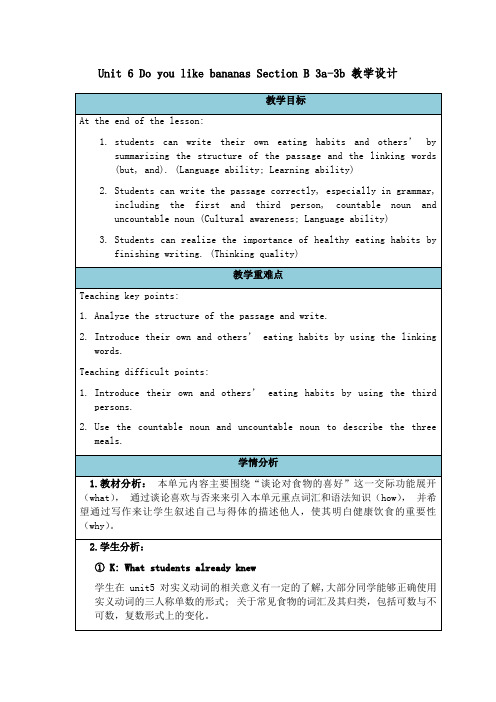
明确写作要求,给出写作内容,明确评价标准。
【设计意图】达到教—学—评一致的要求。
Step4:Post-writing
通过自评与互评的方式来进行修改与订正。
【设计意图】通过自评与互评的方式来提高学生的自学能力。
Step2:Pre-writing
1.让学生制作一份关于他们自己及同伴三餐喜欢及不喜欢的调查表,并完成3a调查表。
2.写出你和同伴一日三餐喜欢吃什么、不喜欢吃什么,完成3b.
3.给出一篇范文,引导学生分析文章结构。
【设计意图】输入语言材料,搭建语言素材;分析语篇结构,为后续写作奠定结构基础。
Step3:while-writing
2.学生分析:
K:What students already knew
学生在unit5对实义动词的相关意义有一定的了解,大部分同学能够正确使用实义动词的三人称单数的形式; 关于常见食物的词汇及其归类,包括可数与不可数,复数形式上的变化。
W:what they want to know
如何对自己及他人的饮食习惯进行得体的描述
Unit 6 Do you like bananas Section B 3a-3b 教学设计
教学目标
Atthe end of the lesson:
1.students can write their own eating habits and others’ by summarizing the structure of the passage and the linking words (but, and). (Language ability; Learning ability)
Unit 6 Section B (3a-3b) 教学设计 人教版英语七年级上册
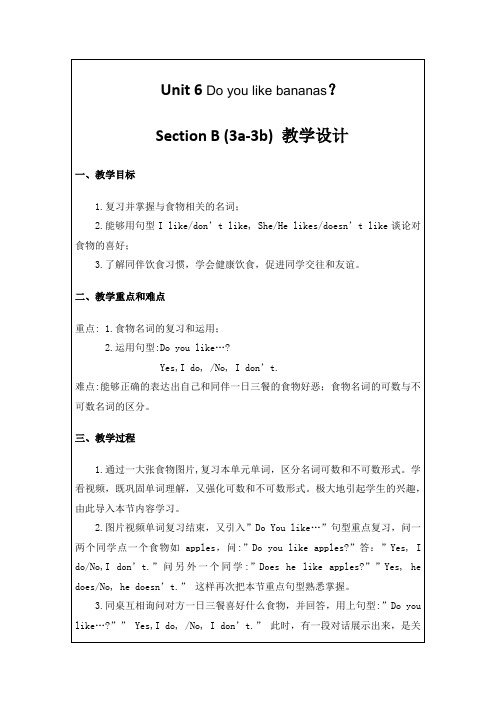
6.为巩固所学知识,写一写家人的食物喜爱。这样,极大地满足孩子们的求知欲,熟练深入地巩固所学知识。
知识是快乐的;老师引导从孩子们平常最喜欢的话题入手,孩子们难道不感兴趣吗?只要有老师乐教的,没有孩子不乐学的。这样的其乐无穷,难道不应该保持吗?我愿陪孩子们一直快乐的成长。
2.运用句型:Do you like…?
Yes,I do, /No, I don’t.
难点:能够正确的表达出自己和同伴一日三餐的食物好恶;食物名词的可数与不可数名词的区分。
三、教学过程
1.通过一大张食物图片,复习本单元单词,区分名词可数和不可数形式。学看视频,既巩固单词理解,又强化可数和不可数形式。极大地引起学生的兴趣,由此导入本节内容学习。
Unit 6
Section B (3a-3b)
一、教学目标
1.复习并掌握与食物相关的名词;
2.能够用句型I like/don’t like, She/He likes/doesn’t like谈论对食物的喜好;
3.了解同伴饮食习惯,学会健康饮食,促进同学交往和友谊。
二、教学重点和难点
重点: 1.食物名词的复习和运用;
2.图片视频单词复习结束,又引入”Do You like…”句型重点复习,问一两个同学点一个食物如apples,问:”Do you like apples?”答:”Yes, I do/No,I don’t.”问另外一个同学:”Does he like apples?””Yes, he does/No, he doesn’t.”这样再次把本节重点句型熟悉掌握。
3.同桌互相询问对方一日三餐喜好什么食物,并回答,用上句型:”Do you like…?””Yes,I do, /No, I don’t.”此时,有一段对话展示出来,是关于3a 调查表完成而设的一段对话。同学们根据对话内容,完成表格,此为提升学生的阅读和理解能力,达到巩固和运用本单元单词和句型的目的。根据阅读,略有一点引导,轻松把3a调查表完成填空,达到3a调查任务学习。让孩子们在愉快中学习,既学到了健康饮食的知识,又学到了合作探究的本事呢。
人教版英语七年级上Unit6Section B3a-3b

sound good
7 体育明星
spots star
1. Do they like hamburgers? (作否定回答) ___N_o_,_t_h_e_y__d_o_n_’t_.___________ 2. My sister likes salad. (对画线部分提问) ___W__h_a_t_d_o_e_s_y_o_u_r__si_s_te_r__li_k_e_?_
2. your, mother, does, apples, like D_o_e_s__y_o_u_r_m__o_th_e_r__li_k_e_a_p_p__le_s_?
3. my, egg, every, an, eats, morning, sister M__y__s_is_t_er__e_a_ts__a_n_e_g_g__e_v_er_y__m_o. rning
把下列句子译成英语。 1. 我们一天吃三顿饭。
We _h_a_v_e_/_e_a_t_ three meals a day. 2. 我早晨7点吃早饭。
I _h_a_v_e__b_r_ea_k__fa_s_t_ at 7:00 in the morning. 3. 汤姆午饭喜欢吃汉堡包和鸡蛋。
Tom likes hamburgers and eggs _f_o_r_lu__n_c_h. 4. 我妈妈不喜欢吃鸡肉。
翻译:我们想成为朋友_______________ fat 反义词___________
连系动词 成为变得 We want to be friends thin
2c Write five sentences about Cindy’s eating habits.
Cindy likes healthy food. 1.Cindy __lo_v_e_s_f_r_u_it_a_n_d__sa_l_a_d_. ___________. 2.She _li_k_e_s_o_r_a_n_g_e_s_a_n_d_a_p_p_l_e_s.___________. 3.She __li_k_e_s_c_h_ic_k_e_n__fo_r_d_i_n_n_e_r_. __________. 4.Cindy doesn’t _li_k_e_h_a_m__b_u_rg_e_r_s_. ________. 5.She doesn’t _e_a_t_i_c_e-_c_r_e_am__. _____________.
人教版七年级英语上册《Unit 6 Section B 3a-Self Check》公开课教学课件
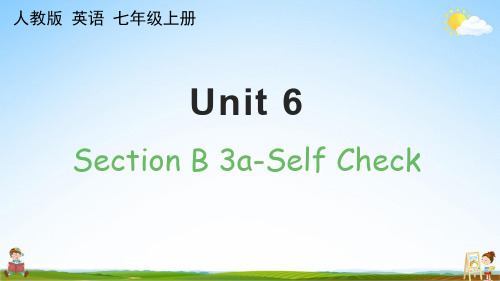
Unit 6Section B 3a-Self Check人教版 英语 七年级上册ØLanguage Goalsu To review the plural forms ofsome countable nouns.u To learn to ask others about whatthey like and they don't like.u To write about what food you liketo eat for meals.ØEmotional Goalu To know your parents, raletives andfriends better, and to know thefood they like and don't like.I like… but I don’t like…orange sbroccoliShe likes… but she doesn’t like…strawberr iessaladFrench frie s tomatoesHe likes… but he doesn’t like…ice cream hamburgersThey like… but they don’t like…chickenpearsDo you like…? No, but I like…Complete the survey.3a—Do you like eggs for breakfast?—No, I don’t. I like oranges.Breakfast Lunch DinnerI likeI don’t likeMy partner likesMy partnerdoesn’t likeWrite about what you and your partner like 3band don’t like for breakfast, lunch and dinner.For breakfast, I like________, but I don’tlike_____________________________For lunch, _______________________And for dinner, ___________________For breakfast, ________likes________For lunch,________________________And for dinner,____________________Self Check1 Do you know the plurals of these words? Put them in the correct columns.hamburger tomato carrotphoto banana strawberryhat table dictionaryegg apple pearradio vegetable familypencil key volleyball+ s+ es y i + es+ s+ es y i + eshamburgerphoto hat egg radiopencil banana table apple vegetable key carrot pear volleyball tomato familystrawberrydictionary2 What food, sports and colors do you like and dislike?I l i k e I d o n’tl i k ebasketball, soccer ball,volleyball, tennis ball,baseball,ping-pong ball swim…white , black, red , orange , yellow, green , blue, pink, purple, brown …apple, orange, pear, strawberry, banana, chicken,salad, milk, carrot,hamburger, watermelon, bread,tomato…foodcolors sports3What food, sports and colors do yourparents like and dislike? Write at leastfive sentences.1.My mother / father likes apples/swimming/red…2. My mother / father doesn’t like pears / basketball /purple…3. My mother / father likes apples/swimming/red… ,but she / he doesn’t like…4. My parents like strawberries/ watching TV / green…Ask your classmates what they like to eat for lunch. Find someone who likes to eat the same lunch as you.NameFoodl_ke ____ ha_e _____at ____ s_ar ____d_nner ____ r__n ___l___ch ____ _ood ____vte i u明星有喜欢跑食物吃晚饭午饭f un i Complete the words and tell us the Chinese meaning of each word.carrottomato pear apple Match the words with the pictures.1.当主语是第一、二人称单复数和第三人称复数时, 肯定句的谓语由动词原形充当。
人教新目标七年级英语上册教案Unit 6 Section B

Unit 6 Do you like bananas?Section BPeriod 1 Section B 1a-2c本单元的核心项目是“喜欢和不喜欢(like and dislike )”。
围绕着这一中心项目,课文中设计了各种食物及水果的插图和不同形式的表格,让学生进行听、说、读、写等各种学习活动。
通过本单元的教学,使学生学会询问对方与了解别人喜欢与不喜欢的食物,学会谈论自己与他人早、中、晚餐喜爱吃的食物,为其今后能在交际中恰当地表达自己的情感、灵活运用已经学过的常用功能项目、进一步学习并掌握新的语言功能奠定坚实的基础。
本单元的重点内容仍然是行为动词在一般现在时句子中的使用,应该是上一个单元内容的延伸,通过本单元的教学,学生应初步掌握行为动词一般现在时的肯定句、否定句、特殊疑问句、一般疑问句的构成以及简单的回答。
【知识与能力目标】1) 继续学习有关膳食名词:breakfast,lunch,dinner,egg,apple,chicken,fruit,vegetables;并能按食品、水果和蔬菜进行分类总结。
2)理解可数名词与不可数名词的概念,并能对所学的词汇进行分辨。
3)就食物的话题开展听、说、读、写技能的训练,促进学生语言运用能力的提高。
【过程与方法目标】采用自主学习、小组合作探究、Different opinions和Classifying的学习策略,利用实物、教学图片等来展开课堂pair work问答式或group work讨论式的口语交际活动,使用like询问对方对食物的喜好和谈论自己、他人喜欢吃的食物。
【情感态度价值观目标】该部分学习内容涉及学生的饮食习惯和偏爱,对培养学生健康的饮食习惯有很强的指导性,能引起学生的特别关注;同时通过互相询问和谈论,培养对家人和同学、朋友的关怀和友爱之情。
【教学重点】1)继续学习运用有关食物的词汇并能按食品、水果和蔬菜进行分类总结。
2)就食物的话题开展听、说、读、写技能的训练,促进学生语言运用能力的提高。
人教版七年级英语上册第六课时 Section B (3a3b)—单元同步作文指导 (2)-课件
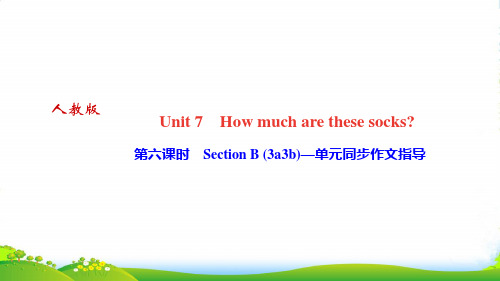
Unit 7 How much are these socks?
第六步作文指导
在七年级的英文书面表达中,有很多都是根据提示翻译完成作文,这 时候需要将所学过的单词,尽量灵活地运用到句子中。具体到本单元的 书面表达中,要求学生们会根据提示(汉语、图片、表格等),写一则促销 广告。
病号3:These socks are very nice.I'll buy them. 【处方】当顾客认为某物很漂亮或价格合理,决 定买下时,常用动词take。故原句应改为“I'll take them.”。 病号4:We have skirts with all colors. 【处方】“in+颜色”常用来表示“……颜色”,故原句中的with应 改为in。 病号5:—What's thirty and eighteen? —It's forty_eight. 【处方】在英语中,在构成两位数的基数词时,十位数和个位数之 间要加连字符“”。故原句中的forty eight应改为fortyeight。
单元常见错误诊断
病号1:We sell jackets for good prices. 【处方】英语中表达“以便宜的价格出售/买进”,常用介词at。表示具 体价格常用介词for。故原句中的for应改为at。 病号2:The Tshirt is 40 yuans. 【处方】在介绍物品价格时,人民币单位常用yuan。yuan没有复数形式, 但是美元dollar有单复数之分。故原句中的yuans应改为yuan或dollars。
【点评】 ①根据提示进行写作,叙述很有条理性,尽量使用了学过的 句子。 ②写作中语言很有吸引力,也就是所写的句子有足够的“煽动 性”,如①、两处的句子使该篇作文更贴近生活,更具有现实意义。
- 1、下载文档前请自行甄别文档内容的完整性,平台不提供额外的编辑、内容补充、找答案等附加服务。
- 2、"仅部分预览"的文档,不可在线预览部分如存在完整性等问题,可反馈申请退款(可完整预览的文档不适用该条件!)。
- 3、如文档侵犯您的权益,请联系客服反馈,我们会尽快为您处理(人工客服工作时间:9:00-18:30)。
第六课时 Section B (3a-3b)— 单元同步作文指导
本单元的写作旨在锻炼大家熟练运用英文表达日期的能力,重点是1到30的序数词的表达和12个月份 的表达方式。同学们只要熟练掌握以上两点,这类作文就不在话下了。在熟练运用所学知识的基础上, 具体到书面表达中,一是要学会如何表达自己的生日、同学的生日以及家人的生日;二是要学会写邀
________________________________________________________________________
________________________________________________________________________
⑤When is Sally's birthday party?莎莉的生日聚会在什么时候? ⑥It's on October 5th.在十月五号。 ⑦Do you like...?你喜欢……吗?
⑧Please come to... next week.请下周来…… ⑨We have a/an...我们有一个…… ⑩See you there!那里见! 拓展相关句型:
篇不少于50词的短文,介绍一下你和你家人的情况。 My name is Jenny.I'm thirteen years old.My birthday is on October 25th.There are four people in my family.They are my father,my mother,my little sister and I.My parents are teachers.My mother's birthday is on July 10th and my father's birthday is on April
【点评】便条的格式规范、正确。便条分为称呼、正文、结束语和署名四部分。称呼一般以Dear... 开头;结束语常写在正文最后一行的下面,也可写在正文后面,常见的结束语有See you soon/there; 署名通常位于右下方,若便条为齐头式,则位于左下方。正确灵活地运用了所学句型,将意思表达完
整,使接收便条的人一目了然。
请便条,正确表达某项活动的日期。 教材中出现的常用句型:
①When is your birthday?你的生日在什么时候? ②My birthday is on October 2nd.我的生日在十月二日。
③Her birthday is in August.她的生日在八月。 ④I'm thirteen (years old).我十三岁。
25th
One po_s_s_i_b_l_e__v_e_r_s_i_o_n_:_________________________________________________________ DnuamvbiedrGir_se_e_8n_1_6i_-s__2m_9y_6_8g_.o_Ho_id_s_f_br_ii_re_tn_hd_d._aH_ye__ii_ss__o1_n4__My_ae_ra_cr_hs__1o_2l_td_h._.H_Hi_es__lt_ie_kl_ee_sp_h_Eo_nn_ge_l_i_s_h______________
热点作文练习
假如下面是你的好朋友David的相关信息。请根据表格内容对他做一下介绍。 要求:50词左右,可适当发挥。
Name Phone Number
David Green 816-2968
Age Date of birth
14 March 12th
Likes Activities
English and math (数学) School trip:September 16th Basketball game:October
经典范文展示二 假如你叫李华,你们学校在下个月(元月)四日有一个英语日活动,请合理发挥想象给你的好朋友汤姆
(Tom)写一张便条,邀请他和你一起去参加这项活动。 Dear Tom,
I know you like school activities.Next month,we have an English Day.Do you like it? Please come to my school.I think you will like it very much.It's on January 4th. See you there! Li Hua
and math_._H_e__t_h_i_n_k_s__t_h_e_y__a_r_e__v_e_r_y__i_n_t_e_r_e_s_t_i_n_g_._H_e__h_a_s__a__s_c_h_o_o_l____________________ t2r5itph..IHte'_sl_i_ok_ne_s_S_et_ph_te_em_m_bv_ee_rr_y_1_6m_tu_hc_.h_T._h_e__b_a_s_k_e_t_b_a_l_l__g_a_m_e__i_s__o_n__O_c_t_o_b_e_r___________________
13th.My little sister is 5 years old,and her birthday is on August 14th. When is your birthday?Please tell me.
【点评】此篇作文根据提示对自己及家庭成员的年龄、生日进行了介绍;正确使用了基数词、序数词 表达年龄、月份和日期,正确使用了年龄及日期的句型,句与句之间衔接自然。
①I know you like... 我知道你喜欢…… ②I think you will like it/them (very much).我认为你将非常喜欢它(们)。
经典范文展示一
假设你叫珍妮(Jenny),今年13岁,出生于10月25日。家里有爸爸妈妈和妹妹。爸爸的生日是4月13 日,妈妈的生日是7月10日,他们都是教师。妹妹今年5岁,出生于8月14日。请你根据以上提示写一
